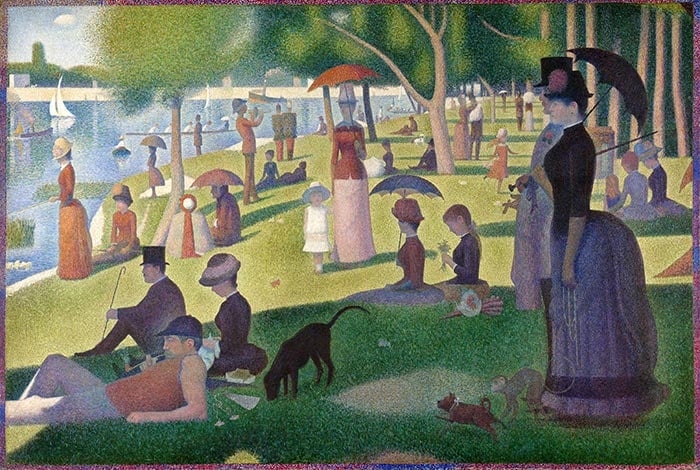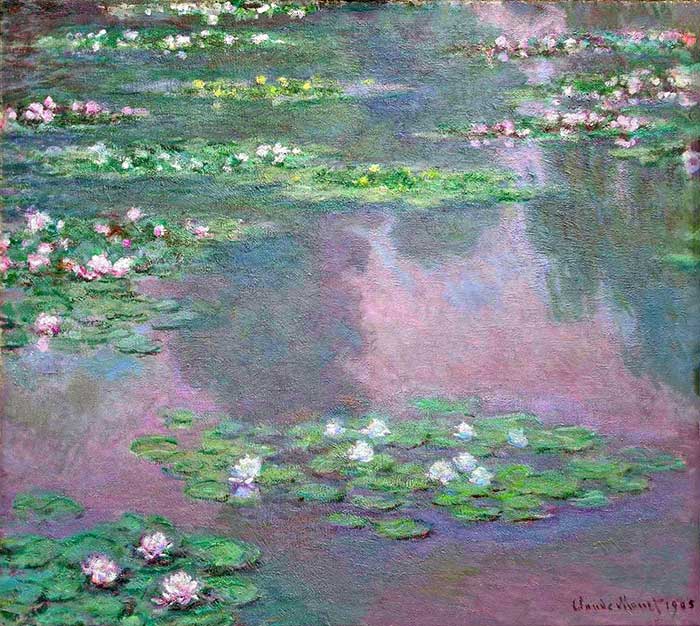What Can Be Used to Create Harmony in a Work of Art?
What Is Harmony in Art?
Harmony is a principle of fine art which refers to how well all the visual elements piece of work together. Elements which are in harmony should accept some kind of logical progression or human relationship. Information technology should just look similar it works.
If there is an element which is non in harmony with the residue of the artwork, information technology should stick-out and be jarring to look at; kind of similar an off notation in a song.
When I think of harmony, the first paintings which come to listen are Monet's h2o lilies serial:

Claude Monet, Water Lilies, 1916
Below are some more than examples of harmony in art.
Harmony in Colour
Harmony in color refers to paintings which utilise a fairly express range of hues. For instance, a painting which features mostly different tones of dark-green, or different tones of blueish. Pablos Picasso's The Old Guitarist is united past the dull, blue tones used in the painting. Fifty-fifty the orangish guitar looks like it is bathed in soft, blue light.

Pablo Picasso, The Old Guitarist, 1904
Monet's painting below demonstrates harmony in colour with by and large greens and dejection used. This is known as an coordinating colour scheme.

Claude Monet, The Japanese Span (The Water Lilly Swimming), 1899
In John Vocaliser Sargent'due southFisherwoman, discover the like oranges and browns used for both the subject and the mural. The bailiwick's wearing apparel nigh blends in with the shore.

John Singer Sargent, Fisherwoman, 1913
(If you desire to learn more about color, make sure to grab my costless Color Theory Crook Sheet).
Harmony in Shape
Shape is a stiff characteristic in most of Paul Cézanne's work. The painting below from his Mont Sainte-Victoire series is united by the rigid, geometric shapes throughout the landscape.

Paul Cézanne, Mont Sainte-Victoire, 1904-1906
Harmony in Value
Value is a powerful visual element which refers to how light or nighttime a color is. You can promote harmony in your painting by uniting colors which are under a tight or compressed value range. For example, a grouping of light colors has a sure harmony considering they are all calorie-free. The same goes for a group of dark colors or colors within the middle-value range.
The two paintings by Monet below are in a loftier cardinal and utilise more often than not light colors. Even though many different hues are used, there is a sense of harmony as about of the colors are in the light value range.

Claude Monet, Charing Cantankerous Bridge, 1903

Claude Monet, Charing Cross Bridge, 1899
[Exercise] Place several different colors on your palette and observe the strong contrast between the colors. Then gradually add more than white to each color. Notice how when more white is added, the more in harmony the colors announced to be.
The painting below by Joaquín Sorolla, on the other manus, is united mostly under a dark value range, except the burst of light effectually the eye.

Joaquín Sorolla, Packaging of Raisins, Javea, 1901
The painting in grayscale gives a better thought of how dark all the colors in shadow are.

Sargent'southward Val d'Aosta features colors which are mostly effectually the middle-value range. There are no potent highlights or intense darks.

John Vocalist Sargent, The Val d'Aosta. Italy, 1910
Harmony in Brushwork
Inconsistent brushwork is one of the most common reasons for a lack of harmony in paintings. Beginners tend to jump from tight brushwork to loose and crude brushwork without any logical progression.
The painting below past Sorolla features fairly loose brushwork throughout the whole painting which provides a strong sense of harmony. Fifty-fifty areas which are completely different are united by the loose brushwork, similar the bright, orange rocks and the deep bluish ocean. It may accept looked out of identify had Sorolla carefully rendered the rocks, whilst keeping the ocean loose and rough.

Joaquín Sorolla, Rocks and White Boat, Javea, 1905
Moscow Courtyard, on the other manus, is united by the delicate and conscientious brushwork throughout the whole painting. Some areas are more simplified than others, but for the most part, the brushwork appears consequent.

Vasily Dmitrievich Polenov, Moscow Courtyard,1878
Harmony in Style
When I think of harmony in fashion, Vincent van Gogh is commencement to come to mind. His paintings are characterized by bold strokes of exaggerated color.

Vincent van Gogh, Olive Trees Under a Yellow Sky, and the Nov Sun, 1889
Below is some other example of harmony in style past Georges Seurat. He utilized a pointillism way, which involved painting small dabs of distinct color to depict form.

Georges Seurat, Sunday Afternoon on the Isle of La Grande Jatte, 1884
Harmony in Field of study
Harmony in subject field ordinarily applies to busy scenes with vast numbers, like Pierre-Auguste Renoir's painting below. Umbrellas and other blue shapes have upward so much of the painting that it creates a sense of harmony.

Pierre-Auguste Renoir, Umbrellas, 1886
Monet'southward water lilies serial is another example; the vast number of water lilies creates a certain harmony throughout the painting.

Claude Monet, Water Lilies, 1905
Additional Resources
If you lot want to acquire more about this topic, you should check out the other principles of art.
I too go into much more than item on the fundamentals in my Painting Academy course.
Thanks for Reading!
Thanks for taking the fourth dimension to read this post. I appreciate it! Feel costless to share with friends. If yous want more than painting tips, check out my Painting Academy course.
Happy painting!

Dan Scott
Draw Paint Academy
Source: https://drawpaintacademy.com/harmony/

0 Response to "What Can Be Used to Create Harmony in a Work of Art?"
Post a Comment